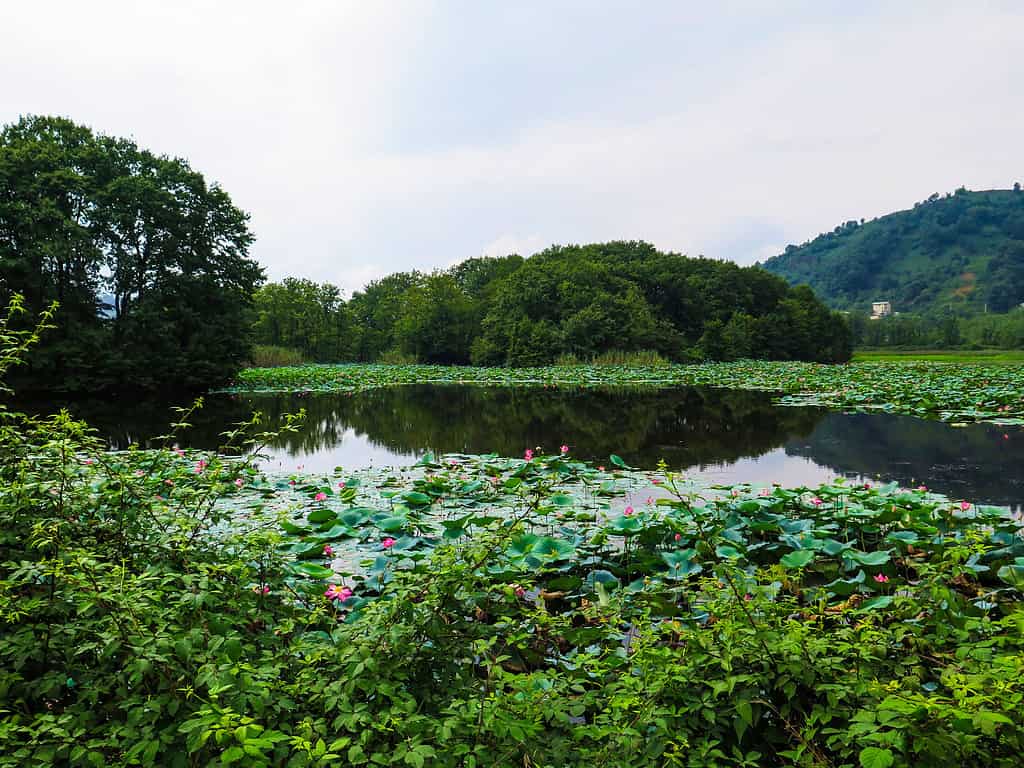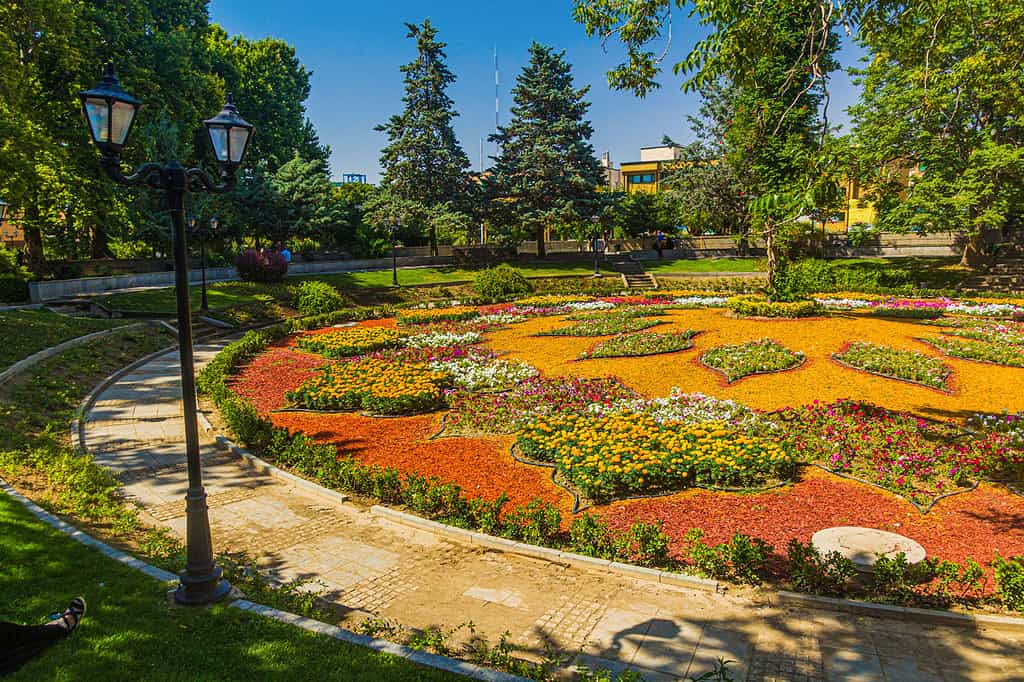Officially known as the Islamic Republic of Iran, this country is located in the Middle East near Western Asia. The country has a fascinating history, and there are many misconceptions about the people of Iran. For example, did you know that Iran is not considered an Arab country? Instead, the largest percentage of the population is Persian, along with other ethnic groups such as Arabs, Kurds, Azeris, and more. Additionally, some of the oldest civilizations in the world had their start in Iran, such as the Elamite Kingdoms. Overall, this is a fascinating part of the world, made even more so when it comes down to its flora. The national flower of Iran, for example, is a beautiful representation of the country.
If you’re interested in learning more about the national flower of Iran and other amazing facts, then keep on reading! We’ll uncover the country’s geography and how it impacted the flora.
The Geographic Context for Iran’s National Flower
As we mentioned, Iran is located in the Middle East. As a Middle Eastern country, the climate is quite dry. The only exception to the arid climate is the coastal areas in the north and western parts of the country. Throughout the summertime, the country has a very hot and dry summer. However, during winter, the temperature can drop a lot, especially in much of the inland regions. Iran also has a rainy period between the months of November all the way into May. Once May hits, the country enters its dry season, which lasts until October.
The country is characterized by lots of mountainous regions. The Zagros Mountains, for example, cut the country in half. The central part of Iran is known as the Central Plateau. Here you’ll find deserts, such as the Great Desert and the Barren Desert. As you can tell, the country’s landscape is quite diverse depending on where you are located. Many mountains, deserts, and land are used for agriculture. As a result of its diversity, the country named a beautiful flower as its national representative. Let’s take a look at what flower it is and what makes it so special.

Alborz mountain range in Tehran, Iran.
©Matyas Rehak/Shutterstock.com
Water Lily: The National Flower of Iran
The water lily is the national flower of Iran. This flower has been Iran’s national flower since the Achaemenid Empire era in 552 BCE. For those of you familiar with this flower, you’ll immediately agree that it is quite memorable for being beautiful. The flower is a part of Nymphaeaceae, which is the water lily family. These flowers are native to both temperate and tropical climates throughout the world. Most of us think of white blooms when we think of this flower. However, they can grow in a variety of colors, including blue, red, orange, yellow, and even purple.
These flowers are very important to their environment as they act as food for both fish and various wildlife. Additionally, they are also great providers of shade in the water. This helps keep the water cooler and is great for preventing algae from growing in excess. They are also simply beautiful to look at and have been known to be used as ornamental flowers. As such a beautiful and beneficial flower, it makes sense that it would be chosen to represent the country. Let’s now learn more about where the water lily grows in Iran.

The water lily has been Iran’s national flower since the Achaemenid Empire era in 552 BCE.
©iStock.com/Marina Denisenko
Where Does the Water Lily Grow in Iran?
As their name implies, water lilies grow in bodies of freshwater. This means these flowers will mostly be found in areas of Iran with water around them. For example, Anzali Lagoon, which is located in northern Iran, is an area that is famously known for its gigantic water lilies. This lagoon is actually one of the most important wetlands in the country. There are actually 11 rivers that flow into this wetland. Another area in Iran where you could find tons of water lilies was Niloofar Sarab — a lake located in Kermanshah province. The name of the lake was actually given to it because of how many water lilies grow here. Sadly, many of the thousands of water lilies have died due to droughts and groundwater harvesting.

The Soostan Lagoon is located in Lahijan, Iran, and it is famous for its water lilies.
©M.Sabouri/Shutterstock.com
What Is the Cultural Significance of the Water Lily?
The water lily has long been a significant cultural symbol throughout many Eastern civilizations. One of the most unique features of the water lily is the fact that its roots and stems are submerged in water, yet the flower continues to face the sun. Despite growing in muddy waters, the flower remains beautiful and triumphant. This is why the Iranian people considered this flower a symbol of purity. Additionally, there is also mythology surrounding the water lily and the goddess Nahid. Nahid was a prominent goddess figure in ancient Iranian traditions. She was the goddess of water, fertility, wisdom, and healing. Thus, the water lily became associated with this goddess.
However, Iran is not the only country to hold the water lily in high regard. This gorgeous flower has been an important symbol in both Buddhism and Hinduism. In these religions, the water lily represents rebirth and resurrection. This is because the flowers have been observed to close up their petals at night and reopen them in the morning to take in the rays of the sun.
How to Grow Water Lilies Indoors
Water lilies are absolutely gorgeous and will often grow in ponds and other bodies of freshwater. However, many people often wonder if it is possible to grow this flower indoors. The short answer is yes! However, it is important to note that although it is possible, that doesn’t mean that it’s easy. Growing a water lily indoors involves a lot of extra care and effort. They are quite picky about their climate, and you’ll have to remember that.
However, if you’re willing to take on the challenge, then there are a few things to keep in mind. For starters, you will need to give them as much sunlight as possible, as these flowers love the sun. In fact, they need four to eight hours of direct sunlight each day! Additionally, it would help if you made sure that the area that you are planning to grow them in has appropriate humidity levels. Most water lilies need temperatures above 70 degrees Fahrenheit in order to do well. You also need to make sure that you have a tank or container in which you can add spring or distilled water. Finally, these plants do best when you add liquid fertilizer or fertilizer pellets to the water and make use of an air bubbler.
Other Native Plants and Flowers of Iran
Iran’s climate and geography are incredibly diverse. As such, there are tons of other native plants and flowers that grow throughout the country. For those who don’t know, many flower festivals are held every year in the country. One of these festivals includes the Tulip Flower Festival. This festival is held every spring in Chamran Park. During this festival, you’ll see tons of beautiful tulips growing, and tons of tourists travel here every year to witness it.
Another amazing species of flower that grows here is Lilium ledebourii. This species is a rare Asian species of lily. This beautiful flower only really grows in two main areas: northern Iran and parts of Azerbaijan. This flower can usually only be seen between the middle of May to the end of May. Many people travel to the Damash area in particular in order to see this beautiful flower bloom.

Ibn Sina (Avicenna) park in Hamadan, Iran, with blossoming flowers.
©Matyas Rehak/Shutterstock.com
The photo featured at the top of this post is © Papp Szabolcs/Shutterstock.com
Thank you for reading! Have some feedback for us? Contact the AZ Animals editorial team.







